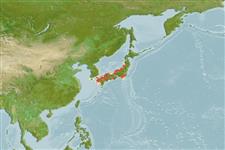>
Syngnathiformes (Pipefishes and seahorses) >
Syngnathidae (Pipefishes and seahorses) > Syngnathinae
Etymology: Hippocampus: Greek, ippos = horse + Greek,kampe = curvature (Ref. 45335); coronatus: Name from Latin which means 'crowned', for its extremely high coronet (Ref. 117115).
More on authors: Temminck & Schlegel.
Issue
The Hippocampus coronatus complex: H. haema, H. coronatus, H. sindonis (Ref. 117115).
Environment: milieu / climate zone / Tiefenbereich / distribution range
Ökologie
seewasser demersal; standorttreu; tiefenbereich 0 - 20 m (Ref. 117115). Subtropical
Northwest Pacific: Japan and South Korea.
This name has been misapplied to Hippocampus sindonis (Ref. 30915).
Length at first maturity / Size / Gewicht / Alter
Geschlechtsreife: Lm 6.0 range ? - ? cm
Max length : 13.3 cm SL Männchen/unbestimmt; (Ref. 117115); common length : 6.0 cm TL Männchen/unbestimmt; (Ref. 559)
Kurzbeschreibung
Bestimmungsschlüssel | Morphologie | Morphometrie
Rückenflossenstacheln (insgesamt) : 0; Rückenflossenweichstrahlen (insgesamt) : 14.
Body shape (shape guide): other.
Inhabits Sargassum belts near shore. Used in Chinese medicine (Ref. 12166). Length type OT refers to height (= TL - head length). Ovoviviparous (Ref. 205). The male carries the eggs in a brood pouch which is found under the tail (Ref. 205).
Male carries the eggs in a brood pouch (Ref. 205).
Lourie, S.A., R.A. Pollom and S.J. Foster, 2016. A global revision of the seahorses Hippocampus Rafinesque 1810 (Actinopterygii: Syngnathiformes): taxonomy and biogeography with recommendations for further research. Zootaxa 4146(1):1-66. (Ref. 115213)
IUCN Rote Liste Status (Ref. 130435: Version 2025-1)
Bedrohung für Menschen
Harmless
Nutzung durch Menschen
Tools
Zusatzinformationen
Download XML
Internet Quellen
Estimates based on models
Preferred temperature (Ref.
123201): 18.3 - 22.6, mean 20.6 °C (based on 103 cells).
Phylogenetic diversity index (Ref.
82804): PD
50 = 0.5000 [Uniqueness, from 0.5 = low to 2.0 = high].
Bayesian length-weight: a=0.00447 (0.00175 - 0.01142), b=2.99 (2.77 - 3.21), in cm total length, based on LWR estimates for this (Sub)family-body shape (Ref.
93245).
Trophic level (Ref.
69278): 3.3 ±0.3 se; based on diet studies.
Widerstandsfähigkeit (Ref.
120179): hoch, Verdopplung der Population dauert weniger als 15 Monate. (Fec > 100).
Fishing Vulnerability (Ref.
59153): Low vulnerability (10 of 100).
🛈
